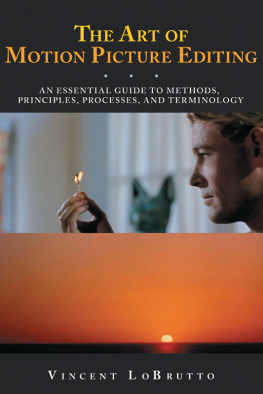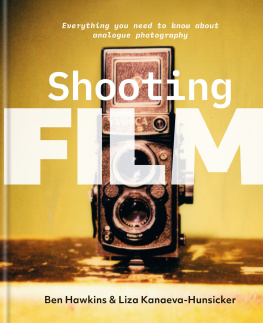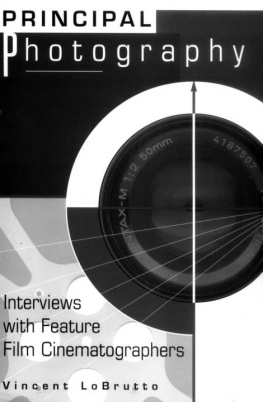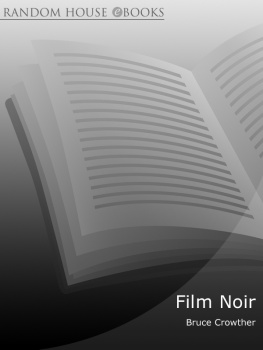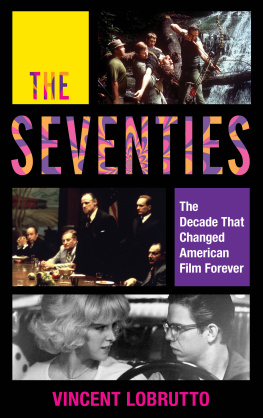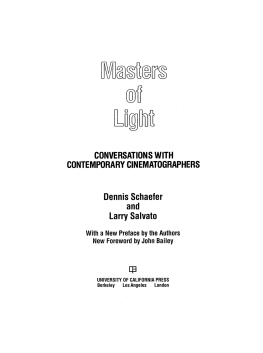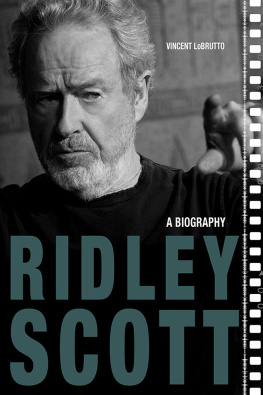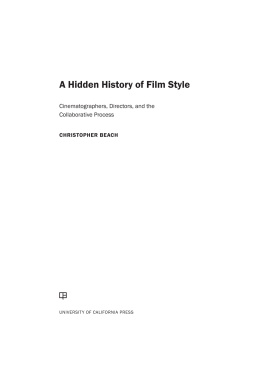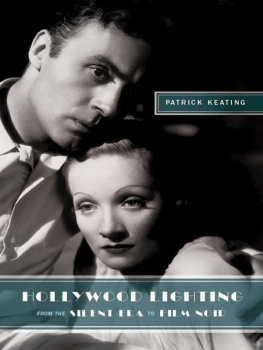LoBrutto - Principal photography: interviews with feature film cinematographers
Here you can read online LoBrutto - Principal photography: interviews with feature film cinematographers full text of the book (entire story) in english for free. Download pdf and epub, get meaning, cover and reviews about this ebook. City: London;Westport;Conn, year: 1999;2009, publisher: Praeger, genre: Art. Description of the work, (preface) as well as reviews are available. Best literature library LitArk.com created for fans of good reading and offers a wide selection of genres:
Romance novel
Science fiction
Adventure
Detective
Science
History
Home and family
Prose
Art
Politics
Computer
Non-fiction
Religion
Business
Children
Humor
Choose a favorite category and find really read worthwhile books. Enjoy immersion in the world of imagination, feel the emotions of the characters or learn something new for yourself, make an fascinating discovery.
Principal photography: interviews with feature film cinematographers: summary, description and annotation
We offer to read an annotation, description, summary or preface (depends on what the author of the book "Principal photography: interviews with feature film cinematographers" wrote himself). If you haven't found the necessary information about the book — write in the comments, we will try to find it.
LoBrutto: author's other books
Who wrote Principal photography: interviews with feature film cinematographers? Find out the surname, the name of the author of the book and a list of all author's works by series.
Principal photography: interviews with feature film cinematographers — read online for free the complete book (whole text) full work
Below is the text of the book, divided by pages. System saving the place of the last page read, allows you to conveniently read the book "Principal photography: interviews with feature film cinematographers" online for free, without having to search again every time where you left off. Put a bookmark, and you can go to the page where you finished reading at any time.
Font size:
Interval:
Bookmark:
PHOTOGRAPHY
PHOTOGRAPHY

Feature Film Cinematographers
Vincent LoBrutto



To my uncle, Gino Damiani, and my father, Anthony LoBrutto, for sharing Kodachrome dreams and to Phil Scandura, who taught me that passion for the arts is contagious.
ix
xi
Thanks to my parents, Rose and Anthony LoBrutto, for their support and for allowing me to borrow the family standard 8mm movie camera to discover my passion for filmmaking. From overseas and cross-country, my children, Rebecca and Alex Morrison, continue to inspire and motivate me with their own flights of discovery. I thank them for their unconditional support. My wife, Harriet Morrison, aided in research, tracked down subjects, chauffeured, acted as consigliere, and, as always, lent her fine hand to the manuscript. My respect and thanks also to Dr. Manhinderjit Singh for his wisdom.
I express my appreciation to the American Society of Cinematographers (ASC) for their assistance, especially Victor J. Kemper, former president, and Karin Sciaratta. American Cinematographer Magazine made an essential contribution to this project. I thank Stephen Pizzello, executive editor, David E. Williams, associate editor, Christopher Probst, technical editor, and George E. Turner, ASC's history maven, for their kindnesses and professionalism. My gratitude to the International Photographers Guild, Local 600, IATSE, particularly George Spiro Dibie, national president.
Thanks to Barbara Halperin of The Gersh Agency, Wayne Fitterman of United Talent Agency, Smith/GosnelI/Nichol son & Associates, and to Everett Aison for help in contacting interview subjects.
My appreciation to Sam Gill of The Margaret Herrick Library in Los Angeles, Kathy Bowles-Ruediger of the Steadicam Operators Association, the New York University Library, and the School of Visual Arts Library for re search materials. I also thank Saal and Deborah Lesser for special support and use of their office facilities.
My heartfelt thanks to everyone at the School of Visual Arts, especially Reeves Lehmann, chairman of the Department of Film, Video, and Animation, and Sal Petrosino, director of operations, for their unconditional support and friendship. Thanks to all my colleagues and students for inspiration and encouragement. My appreciation to instructor and cinematographer Igor Sunara, who told me as I was about to embark on this project, "Everyone says,'cinematography is about light.' Cinematography is not just about light. Cinematography is about movement and light."
Sincere thanks to the entire staff at Le Montrose Hotel in West Hollywood for their hospitality, especially John C. Douponce, general manager, and to John Sawyer for driving skills second only to Kerouac's Dean Moriarty.
I am most indebted to the thirteen cinematographers who took time out of their busy working and personal lives to allow me to learn firsthand about the art and craft of cinematography. This book would not exist without their knowledge and commitment.
I respectfully recognize the passing of Stanley Cortez, ASC, and Linwood G. Dunn, who were not able to share their extensive knowledge and experience about cinematography with me.
My sincere thanks to Michael Ballhaus, Ralf Bode, Fred Murphy, and Robert Richardson, who, by spending many hours sharing with me their passion, knowledge, and experience about cinematography, enriched my understanding and respect for this craft. Time, logistics, and space did not allow me to talk to cinematographer Philippe Rousselot; I thank him for his interest in this project.
I want to thank everyone at Praeger Publishers for their continued support and the care and attention they provide. Particular thanks go to this book's original editor, Nina Pearlstein, and to Elisabetta Linton, who faithfully saw the project to conclusion. The manuscript was given expert care by the production editor, Heidi Straight, and the copyeditor, Frances Lyon. My thanks to John Bailey for reviewing the glossary and for his expert comments.
Filmmaking is a collaborative process, as is a book of interviews; again my thanks to all who have contributed to this project.
The purpose of this book is to allow cinematographers to speak in their own words about the art and craft of cinematography.
On the surface, cinematography is not hidden in the mysteries that surround the crafts of editing, production design, and film sound. The photography of a film is there for all to see. Audiences have been educated in interpreting photographic beauty and drama and in understanding that images come from light and shadow, but the layers of narrative and the atmospheric and psychological impact imparted by the camera suggest and demand a deeper understanding. This deeper awareness is informed by the role of the cinematographer-this most important cinematic collaborator.
Without light there would be no image, without movement there would be no motion pictures. Cinematography visually presents points of view and the verisimilitude and artificiality of movement for a narrative or psychological purpose. The camera records the force and subtleties of the actor's performance and places it in context within the physical environment of a scene. Cinematographers interpret a written screenplay in visual images. On the set, they translate the director's vision to a series of shots, long and short and in a catalogue of compositions, angles, and lens sizes so that these pieces can later come together as cinematic storytelling presented in images and sound.
The cinematographer reports to the director and, with the production designer, is a member of the triad who create the visual style or look of a film. The director of photography is the head of a department including the assistant cameramen, camera operator, electrician, gaffer, and grip.
During the studio system, cinematographers primarily worked in blackand-white and.created the rules for Hollywood filmmaking that lasted until the mid-sixties. Conventions such as back light, which added pictorial beauty; diffusion, which eliminated flaws in the face; low angles, which created size and importance; and eyeline-matches, which linked the composition of one actor to another became the cinematic language filmmakers embraced to present their narratives.
The cinematographers in this volume helped rewrite the cinematic language used to make movies. During the sixties and seventies, cinematographers began utilizing natural light and more portable equipment to create contemporary images. Handheld camerawork, desaturated color, flares, the zoom lens, and the invention of the Steadicam transformed the formal aspects of the craft as filmmakers began creating a new kind of cinema which reflected our rapidly changing times and technology.
Font size:
Interval:
Bookmark:
Similar books «Principal photography: interviews with feature film cinematographers»
Look at similar books to Principal photography: interviews with feature film cinematographers. We have selected literature similar in name and meaning in the hope of providing readers with more options to find new, interesting, not yet read works.
Discussion, reviews of the book Principal photography: interviews with feature film cinematographers and just readers' own opinions. Leave your comments, write what you think about the work, its meaning or the main characters. Specify what exactly you liked and what you didn't like, and why you think so.


